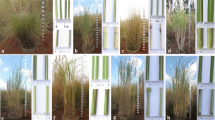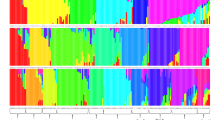Abstract
Saccharum spontaneum L. plays a key role in the improvement of stress resistance and yield of sugarcane cultivars by serving as wild parent sources, especially lines of different ploidy. To better understand the genetic diversity and potential breeding value of S. spontaneum with different ploidy levels, 62 clones from four ploidy types (2n = 64, 72, 80, and 96) were screened using 30 pairs of SSR primers and with population genetics methods. The results showed that the decaploid and octaploid populations had a higher diversity than nonaploid and dodecaploid populations at 30 SSR loci with >98 % percentage of polymorphic bands and >0.92 polymorphic information content. Both the octaploid and decaploid populations shared more common bands with commonly used parents than the nonaploid or dodecaploid populations. The analysis of Nei’s genetic distance and UPGMA tree indicates that the decaploid population had the closest genetic relationship with the octaploid population and that the two populations had a close genetic relationship with commonly used parents (controls). According to the population divergence analysis, the four different ploidy populations did not show an obvious genetic divergence (Gst) (0.0880), but clearly had large amounts of gene flow (Nm) (5.1840). Octaploid and decaploid populations appeared to have undergone more genetic exchange with commonly used parents, as indicated by the low Gst value (0.1254 and 0.1276) and high Nm value (3.4872 and 3.4186). These results may provide important insight into utilizing the diversity of clones with different ploidy levels in S. spontaneum for future sugarcane breeding.

Similar content being viewed by others
References
Aitken, K.S., P.A. Jackson, and C.L. McIntyre. 2005. A combination of AFLP and SSR markers provides extensive map coverage and identification of homo (eo) logous linkage groups in a sugarcane cultivar. Theoretical and Applied Genetics 110(5): 789–801.
Alwala, S., A. Suman, J.A. Arro, J.C. Veremis, and C.A. Kimbeng. 2006. Target region amplification polymorphism (TRAP) for assessing genetic diversity in sugarcane germplasm collections. Crop Science 46(1): 448–455.
Cai, Q., J.C. Wen, Y.H. Fan, L.P. Wang, and L. Ma. 2002. Chromosome analysis of Saccharum L. and related plants. Southwest China Journal of Agricultural Sciences 15(2): 16–19.
Chang, D., F.Y. Yang, J.J. Yan, Y.Q. Wu, S.Q. Bai, X.Z. Liang, and Y.M. Gan. 2012a. SRAP analysis of genetic diversity of nine native populations of wild sugarcane, Saccharum spontaneum, from Sichuan, China. Genetics and Molecular Research 11(2): 1245–1253.
Chang, D., J.J. Yan, S.Q. Bai, and X.Z. Liang. 2012b. Evaluation of production performance for wild Saccharum spontaneum L. Germplasm. Chinese Agricultural Science Bulletin 3: 039.
Chen, R.K. 2011. Theory and practice in modern sugarcane breeding, 1–19. Beijing: China Agriculture Press.
Chen, H., Y.H. Fan, X.W. Shi, Q. Cai, M. Zhang, and Y.P. Zhang. 2001. Research on genetic diversity and systemic evolution in Saccharum spontaneum L. Acta Agronomica Sinica 27(5): 645–652.
Cuadrado, A., R. Acevedo, S.M.D. de la Espina, N. Jouve, and C. De La Torre. 2004. Genome remodelling in three modern S. officinarum × S. spontaneum sugarcane cultivars. Journal of Experimental Botany 55(398): 847–854.
da Silva, J., R.J. Honeycutt, W. Burnquist, S.M. Al-Janabi, M.E. Sorrells, S.D. Tanksley, and B.W. Sobral. 1995. Saccharum spontaneum L. ‘SES 208’genetic linkage map combining RFLP-and PCR-based markers. Molecular Breeding 1(2): 165–179.
D’Hont, A., D. Ison, K. Alix, C. Roux, and J.C. Glaszmann. 1998. Determination of basic chromosome numbers in the genus Saccharum by physical mapping of ribosomal RNA genes. Genome 41(2): 221–225.
D’Hont, A. 2005. Unravelling the genome structure of polyploids using FISH and GISH; examples of sugarcane and banana. Cytogenetic and Genome Research 109(1–3): 27–33.
Doyle, J.J., and J.L. Doyle. 1990. Isolation of plant DNA from fresh tissue. Focus 12: 13–15.
Fan, Y., H. Chen, X. Shi, Q. Cai, M. Zhang, and Y. Zhang. 2001. RAPD analysis of Saccharum spontaneum from different ecospecific colonies in Yunnan. Acta Botanica Yunnanica 23(3): 298–308.
Fan, L.N., H.H. Deng, Q.W. Luo, H.Y. He, Y. Li, Q.N. Wang, and Y.W. Qi. 2012. Genetic diversity of Saccharum spontaneum from geographical regions of China assessed by simple sequence repeats. Genetics and Molecular Research 12(4): 5916–5925.
Govindaraj, P., V.A. Amalraj, K. Mohanraj, and N.V. Nair. 2014. Collection, characterization and phenotypic diversity of Saccharum spontaneum L. from arid and semi arid zones of northwestern India. Sugar Tech 16(1): 36–43.
Guo, B.Z. 1987. The Flora of China, vol. 10, No. 2. Beijing: China Science Press, p. 40
Ha, S., P.H. Moore, D. Heinz, S. Kato, N. Ohmido, and K. Fukui. 1999. Quantitative chromosome map of the polyploid Saccharum spontaneum by multicolor fluorescence in situ hybridization and imaging methods. Plant Molecular Biology 39(6): 1165–1173.
Henry, R.J., and C. Kole. 2010. Genetics, genomics and breeding of sugarcane, 1–9. New Hampshire: Science Publishers.
Liu, S.M., Q.N. Wang, Z.X. Huang, C.M. Zhang, H.X. Hu, C. Fu, and F. Zhou. 2011. Utilization of sugarcane parents of Yacheng series in sugarcane breeding of China. Sugarcane and Canesugar 4: 5–10.
Liu, X.L., H.S. Su, X.M. Ying, L. Ma, X. Lu, H.B. Liu, and Z.H. Deng. 2013. Phenotypic correlation and genetic diversity of decaploids of Saccharum spontaneum. Journal of Hunan Agricultural University (Natural Sciences) 38: 574–579.
Liu, X.L., Q. Cai, Y. Bi, X. Lu, L. Ma, X.M. Ying, and J. Mao. 2009. A rapid silver staining method for PAGE used in sugarcane AFLP and SSR molecular markers. Jiangsu Journal of Agricultural Sciences 25: 433–435.
Liu, X.L., J. Mao, X. Lu, L. Ma, S.A. Karen, P.A. Jackson, Q. Cai, and Y.H. Fan. 2010. Construction of molecular genetic linkage map of sugarcane based on SSR and AFLP markers. Acta Agronomica Sinica 36(1): 177–183.
Mary, S., N.V. Nair, P.K. Chaturvedi, and A. Selvi. 2006. Analysis of genetic diversity among Saccharum spontaneum L. from four geographical regions of India, using molecular markers. Genetic Resources and Crop Evolution 53(6): 1221–1231.
Milbourne, D., R. Meyer, J.E. Bradshaw, E. Baird, N. Bonar, J. Provan, W. Powell, and R. Waugh. 1997. Comparison of PCR-based marker systems for the analysis of genetic relationships in cultivated potato. Molecular Breeding 3(2): 127–136.
Miller, M.P. 1997. Tools for population genetic analyses (TFPGA) 1.3: A windows program for the analysis of allozyme and molecular population genetic data. Computer Software Distributed by Author 4: 157.
Pan, Y.B., D.M. Burner, B.L. Legendre, M.P. Grisham, and W.H. White. 2005. An assessment of the genetic diversity within a collection of Saccharum spontaneum L. with RAPD-PCR. Genetic Resources and Crop Evolution 51(8): 895–903.
Pan, Y.B. 2006. Highly polymorphic microsatellite DNA markers for sugarcane germplasm evaluation and variety identity testing. Sugar Tech 8(4): 246–256.
Panje, R., and C. Babu. 1960. Studies in Saccharum spontaneum distribution and geographical association of chromosome numbers. Cytologia 25(2): 152–172.
Peakall, R., and P.E. Smouse. 2006. GENALEX 6: genetic analysis in Excel. Population genetic software for teaching and research. Molecular Ecology Notes 6(1): 288–295.
Qi, Y.W., L.N. Fan, H.Y. He, Y.S. Chen, J.H. Ao, and H.H. Deng. 2009. Genetic diversity assessment of Saccharum spontaneum L. native to Guangdong area with agronomic traits. Sugarcane and Canesugar 3:7–10.
Srivastava, S., P.S. Gupta, P.K. Singh, J. Singh, and R. Jain. 2011. Genetic diversity analysis of Saccharum spontaneum germplasm using SSR-SSCP and RAPD markers. Indian Journal of Agricultural Sciences 81(10): 914–920.
Sreenivasan, T.V., B.S. Ahloowalia, and D.J. Heinz. 1987. Cytogenetics. In Sugarcane improvement through breeding, ed. D.J. Heinz, 211–253. Amsterdam: Elsevier Press.
Wang, S.Q., Z.L. Wang, and C.F. Guo. 1996. Studies on the chromosome of Saccharum spontaneum from Fujian. Sugarcane and Canesugar 5: 9–13.
Yang, H.X. 2013. Application of SCoT molecular marker in Saccharum spontaneum L. Journal of Plant Genetic Resources 14(4): 704–710.
Yang, S.C., Y.H. Li, Q.H. Yang, F.S. Li, and G.L. Xiao. 2008. Relations between photosynthesis characteristics of Saccharum spontaneum and altitude of its native area. Sugar Crops of China 1: 003.
Yeh, F.C., R.C. Yang, B.J.T. Boyle, Z.H. Ye, and X.J. Mao. 1999. POPGENE 32 version1.32. The user-friendly shareware for population genetic analysis. Alberta: Molecular Biology and Biotechnology Centre, University of Alberta.
Zhang, G.M., R.Z. Yang, H.B. Liu, and W.K. Fang. 2006. Principal component analysis for 7 quantitative traits and cluster analysis based on 7 quantitative traits of Saccharum spontaneum L. Southwest China Journal of Agricultural Sciences 19(6): 1127–1131.
Zhang, G.M., Y.R. Li, W.Z. He, H. He, X.H. Liu, H.Z. Song, and W.K. Fang. 2010. Analysis of the genetic diversity in Saccharum spontaneum L. accessions from Guangxi province of China with RAPD-PCR. Sugar Tech 12(1): 31–35.
Acknowledgments
This work was supported by the Yunnan Natural Science Foundation (2011FB120), the National Natural Science Foundation of China (31360359), the Earmarked Fund for the Modern Agriculture Technology of China (CARS-20-1-5), and Candidates of the Young and Middle Aged Academic Leaders of Yunnan Province (2014HB038). We would also like to thank LetPub (www.letpub.com) for linguistic assistance during the preparation of this manuscript.
Author information
Authors and Affiliations
Corresponding author
Rights and permissions
About this article
Cite this article
Liu, X.L., Li, X.J., Xu, C.H. et al. Genetic Diversity of Populations of Saccharum spontaneum with Different Ploidy Levels Using SSR Molecular Markers. Sugar Tech 18, 365–372 (2016). https://doi.org/10.1007/s12355-015-0399-5
Received:
Accepted:
Published:
Issue Date:
DOI: https://doi.org/10.1007/s12355-015-0399-5




